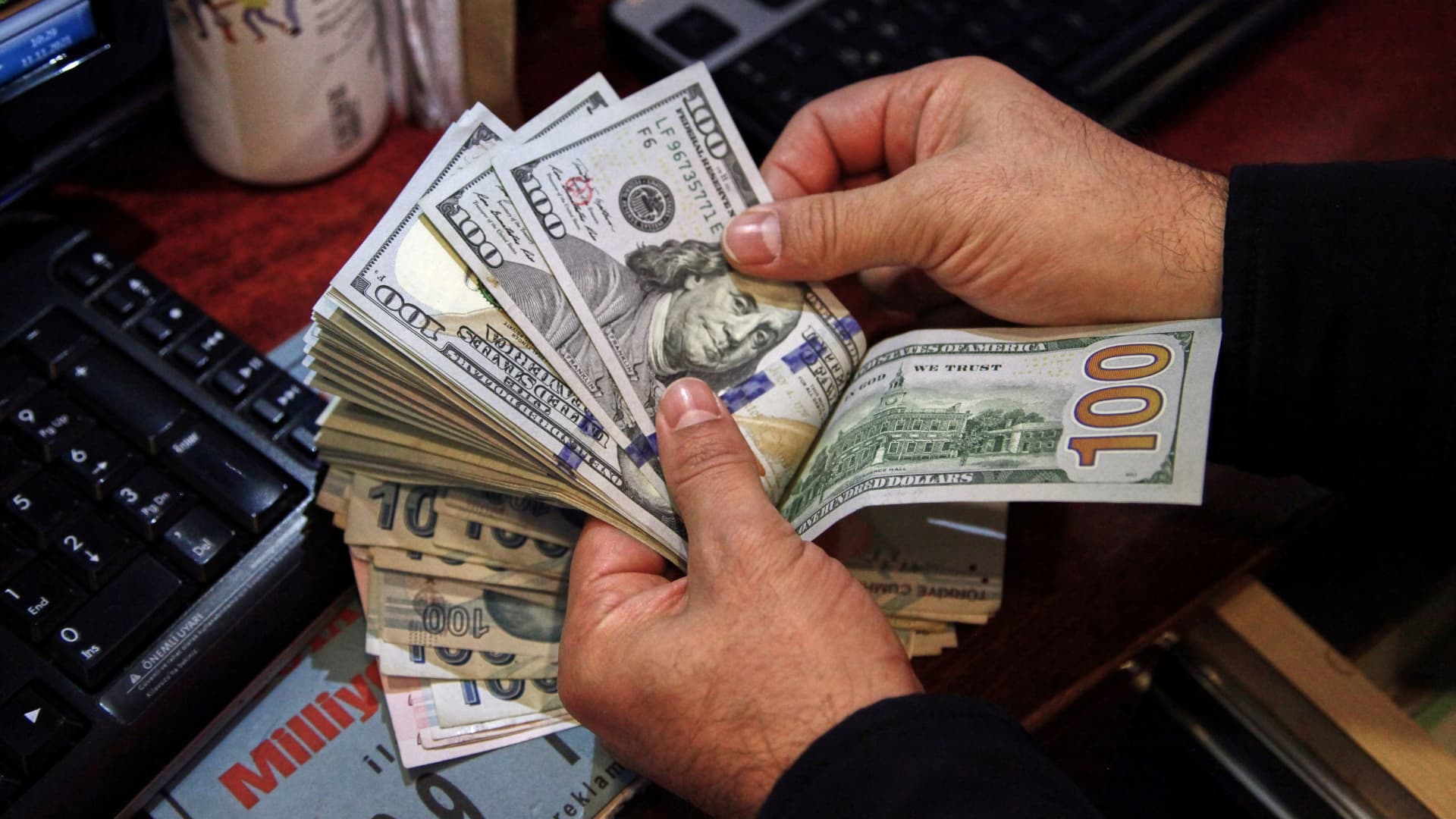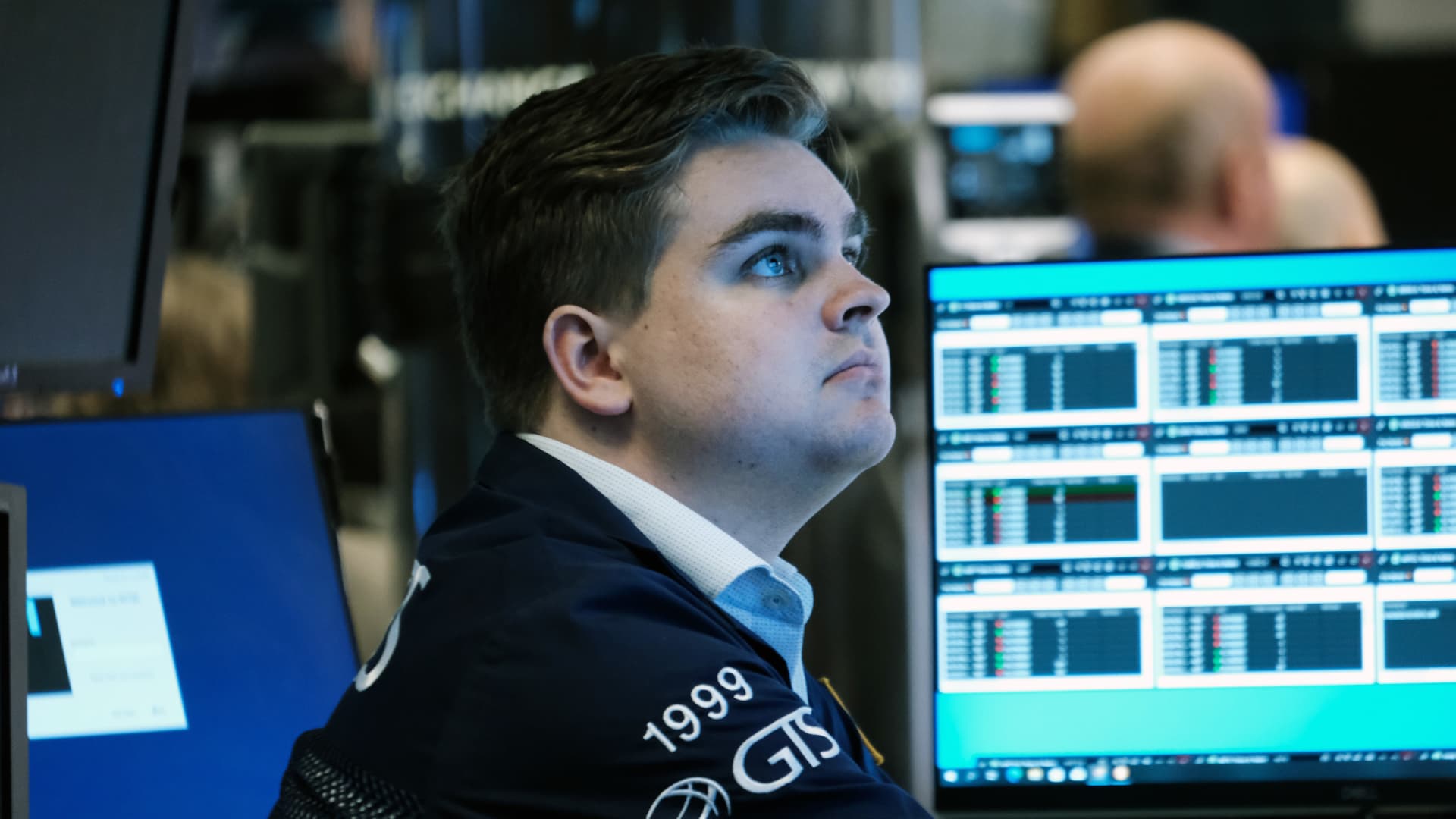https://theinvestorsedge.io/the-u-s-dollar-hasnt-been-this-strong-in-two-decades-and-thats-another-problem-for-stocks/
US Markets
Thursday, September 8th, 2022 2:12 pm EDT

The U.S. dollar’s stunning climb to multi-decade highs has put stocks on an unsteady footing that could continue until investors see a high-water mark for U.S. interest rates. As the dollar edges higher, investors have become increasingly worried that the Federal Reserve may be too aggressive with interest rate hikes. Some strategists say investors are hoping for a clearer sign on where and when the Fed will stop. Both the dollar and Treasury yields rose Thursday after Federal Reserve Chair Jerome Powell again vowed to lift rates until the central bank’s fight against inflation succeeds. The 10-year Treasury yield rose to 3.29%, just below its recent high. Yields move opposite price. The dollar index, up 14% for 2022 so far, was at a 20-year high this week but was off the high at 109.99 Thursday. British sterling was at a 1985 low, and the yen was at its lowest in 24 years. The euro was trading below par at 0.999, a 20-year low. Those currencies are falling against the dollar, as other central banks move to keep up with the Fed’s pace of rate hikes. Stocks can be adversely affected by a stronger dollar, since it makes the foreign revenues of multinationals worth less. There is also the double sting of higher interest rates which gnaw away at the valuations of growth and technology companies, as the cost of money rises. The Fed is widely expected to fire off its third 75 basis point, or three-quarter point, rate hike Sept. 21. Even as the European Central Bank raised its rate by 75 basis points Thursday, the ECB still lags the U.S. central bank. The European benchmark deposit rate is now 75 basis points, well below the Fed’s 2.25% to 2.50% target fed funds rate range. A basis point equals 0.01 percentage point. The Bank of Canada raised its policy interest rate by 75 basis points Wednesday, and Australia’s central bank raised its rate by a half percentage point Tuesday. “This is an extraordinary period for the currency market when you had the Fed starting late, behind the curve and then catching up by front loading,” said Quincy Krosby, chief global strategist at LPL Financial. “It is overall the interest rate differential with the U.S. leading, not only with hawkish rhetoric but also with hawkish policy measures. Once that eases, you’re going to see the dollar weaken, but it’s not going to collapse.” The expectations for Fed rate hikes have been moving up, with the market now putting high odds on a third three-quarter point hike, versus the half point move that some economists expect. The futures market has also edged up the terminal, or end rate, for fed funds to just about 4% by the first quarter of 2023. “Broadly speaking, I think the dollar strength carries into early next year,” said Marc Chandler, chief market strategist at Bannockburn Global Forex. “What the market is really watching is what the terminal rate for fed funds is. Right now, the market is saying it’s 4% … . Once it has a better handle on that, I think the stock market has a rally.” Chandler noted that Cleveland Fed President Loretta Mester upped the rhetoric Wednesday by saying inflation remains very high and the fed funds rate could go “somewhat above” 4% by early next year. “Ignoring the message of plunging inflation ‘breakevens’ opens the risks for the Fed that they end up making the diametric opposite mistake of last year’s ‘transitory’ argument,” said Julian Emanuel, head of equity, derivative and quantitative research at Evercore ISI. Emanuel said a bond market measure for inflation shows investors expect inflation over the next five years to average 2.5%. The last consumer price index reading showed inflation galloping higher at an 8.5% rate, though economists expect falling oil prices to ease up CPI inflation when the August report is released Sept. 13. The Fed had initially argued that high inflation was a “transitory” problem for the economy, created by the pandemic and supply chain distortions. The Fed is expected to release new projections for inflation, the economy and the fed funds rate at the September meeting. In June, Fed officials forecast a median fed funds target rate of 3.8% for 2023, falling to 3.4% by the next year. Emanuel said the market is not so intent on when the Fed ends, but how far it and other central banks go. “Everyone is now operating on the same bazooka type footing as the Fed. The fact is that when you look at it, you can make the case the Fed should start easing off because inflation is falling,” he said. Greg Faranello, head of U.S. rates at AmeriVet Securities, said the volatile markets have been adjusting to the idea of higher rates. “The Fed is saying for the first time in a long time we want to get to a certain level but don’t expect us to leave it anytime soon,” he said. “That’s a pretty powerful message. Powell was driving it today. I think it’s a big pushback in terms of how this market was behaving.” Faranello said he has been bullish on the dollar for most of this year, but he’s currently paring back some of those expectations. The dollar is still benefiting from a flight-to-safety trade from geopolitical developments, he added. “We think the Fed is getting closer to an endgame, with a 4% terminal rate,” he said. “We’ve been happy to sell into the strength we’re seeing, given what I think the other central banks are doing.” He said a weakening dollar, as a result, could be positive for stocks. Krosby said at some point the other central banks will seem more aggressive than the Fed, and that could bring some dollar weakness. She said that would be good for stocks, and U.S. exporters would be helped by a weaker dollar. She said the S & P 500 makes about 30% to 35% of its revenues in foreign countries. “It’s a complicated story. To make it easier to understand, you have to look at the earnings,” she said. In the second quarter, ” You heard from Microsoft . You heard from Johnson and Johnson . You heard from Nike. They were all hit by a stronger dollar.” But Krosby added companies have different ways of hedging against currency fluctuation and some operations run in local currencies. Therefore, the impact is very different for individual companies. She said a stock like Apple, which buys and sells in China, could face headwinds from continued dollar strength.
A money changer counts U.S. dollar banknotes at a currency exchange office in Ankara, Turkey November 11, 2021.
Cagla Gurdogan | Reuters
The U.S. dollar’s stunning climb to multi-decade highs has put stocks on an unsteady footing that could continue until investors see a high-water mark for U.S. interest rates.
As the dollar edges higher, investors have become increasingly worried that the Federal Reserve may be too aggressive with interest rate hikes. Some strategists say investors are hoping for a clearer sign on where and when the Fed will stop.
Both the dollar and Treasury yields rose Thursday after Federal Reserve Chair Jerome Powell again vowed to lift rates until the central bank’s fight against inflation succeeds. The 10-year Treasury yield rose to 3.29%, just below its recent high. Yields move opposite price.
The dollar index, up 14% for 2022 so far, was at a 20-year high this week but was off the high at 109.99 Thursday. British sterling was at a 1985 low, and the yen was at its lowest in 24 years. The euro was trading below par at 0.999, a 20-year low.
Those currencies are falling against the dollar, as other central banks move to keep up with the Fed’s pace of rate hikes. Stocks can be adversely affected by a stronger dollar, since it makes the foreign revenues of multinationals worth less. There is also the double sting of higher interest rates which gnaw away at the valuations of growth and technology companies, as the cost of money rises.
The Fed is widely expected to fire off its third 75 basis point, or three-quarter point, rate hike Sept. 21. Even as the European Central Bank raised its rate by 75 basis points Thursday, the ECB still lags the U.S. central bank. The European benchmark deposit rate is now 75 basis points, well below the Fed’s 2.25% to 2.50% target fed funds rate range. A basis point equals 0.01 percentage point.
The Bank of Canada raised its policy interest rate by 75 basis points Wednesday, and Australia’s central bank raised its rate by a half percentage point Tuesday.
“This is an extraordinary period for the currency market when you had the Fed starting late, behind the curve and then catching up by front loading,” said Quincy Krosby, chief global strategist at LPL Financial. “It is overall the interest rate differential with the U.S. leading, not only with hawkish rhetoric but also with hawkish policy measures. Once that eases, you’re going to see the dollar weaken, but it’s not going to collapse.”
The expectations for Fed rate hikes have been moving up, with the market now putting high odds on a third three-quarter point hike, versus the half point move that some economists expect. The futures market has also edged up the terminal, or end rate, for fed funds to just about 4% by the first quarter of 2023.
“Broadly speaking, I think the dollar strength carries into early next year,” said Marc Chandler, chief market strategist at Bannockburn Global Forex. “What the market is really watching is what the terminal rate for fed funds is. Right now, the market is saying it’s 4% … . Once it has a better handle on that, I think the stock market has a rally.”
Chandler noted that Cleveland Fed President Loretta Mester upped the rhetoric Wednesday by saying inflation remains very high and the fed funds rate could go “somewhat above” 4% by early next year.
“Ignoring the message of plunging inflation ‘breakevens’ opens the risks for the Fed that they end up making the diametric opposite mistake of last year’s ‘transitory’ argument,” said Julian Emanuel, head of equity, derivative and quantitative research at Evercore ISI. Emanuel said a bond market measure for inflation shows investors expect inflation over the next five years to average 2.5%.
The last consumer price index reading showed inflation galloping higher at an 8.5% rate, though economists expect falling oil prices to ease up CPI inflation when the August report is released Sept. 13. The Fed had initially argued that high inflation was a “transitory” problem for the economy, created by the pandemic and supply chain distortions.
The Fed is expected to release new projections for inflation, the economy and the fed funds rate at the September meeting. In June, Fed officials forecast a median fed funds target rate of 3.8% for 2023, falling to 3.4% by the next year.
Emanuel said the market is not so intent on when the Fed ends, but how far it and other central banks go.
“Everyone is now operating on the same bazooka type footing as the Fed. The fact is that when you look at it, you can make the case the Fed should start easing off because inflation is falling,” he said.
Greg Faranello, head of U.S. rates at AmeriVet Securities, said the volatile markets have been adjusting to the idea of higher rates. “The Fed is saying for the first time in a long time we want to get to a certain level but don’t expect us to leave it anytime soon,” he said. “That’s a pretty powerful message. Powell was driving it today. I think it’s a big pushback in terms of how this market was behaving.”
Faranello said he has been bullish on the dollar for most of this year, but he’s currently paring back some of those expectations. The dollar is still benefiting from a flight-to-safety trade from geopolitical developments, he added.
“We think the Fed is getting closer to an endgame, with a 4% terminal rate,” he said. “We’ve been happy to sell into the strength we’re seeing, given what I think the other central banks are doing.” He said a weakening dollar, as a result, could be positive for stocks.
Krosby said at some point the other central banks will seem more aggressive than the Fed, and that could bring some dollar weakness. She said that would be good for stocks, and U.S. exporters would be helped by a weaker dollar.
She said the S&P 500 makes about 30% to 35% of its revenues in foreign countries. “It’s a complicated story. To make it easier to understand, you have to look at the earnings,” she said. In the second quarter, “You heard from Microsoft. You heard from Johnson and Johnson. You heard from Nike. They were all hit by a stronger dollar.”
But Krosby added companies have different ways of hedging against currency fluctuation and some operations run in local currencies. Therefore, the impact is very different for individual companies.
She said a stock like Apple, which buys and sells in China, could face headwinds from continued dollar strength.
This post has been syndicated from a third-party source. View the original article here.





